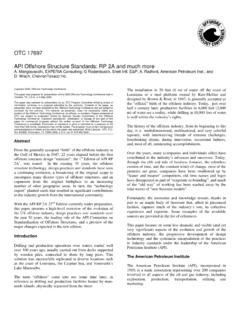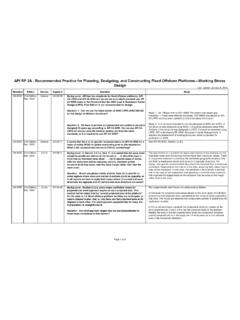Transcription of REASSESSMENT ISSUES IN LIFE CYCLE STRUCTURAL …
1 Proceedings of OMAE2002: st 21 International Conference on offshore Mechanics & Arctic Engineering 23-28 June 2002, Oslo, Norway OMAE2002-28610. REASSESSMENT ISSUES IN life CYCLE STRUCTURAL INTEGRITY. MANAGEMENT OF FIXED STEEL INSTALLATIONS. A. Stacey & M. Birkinshaw J. V. Sharp offshore Safety Division, Cranfield University, HSE, Cranfield, London, UK Bedfordshire, UK. ABSTRACT INTRODUCTION. In offshore locations around the world many installations There is an increasing number of ageing installations in are approaching or have exceeded their original design UK waters, many of which are being or will be operated lives. Hence, REASSESSMENT is a key consideration and beyond their original planned service life . This important the criteria for this process are becoming established.
2 Trend, in combination with (a) the introduction of risk- These criteria are sufficiently different for large manned based goal-setting regulations which require the installations, often operated in the North Sea, compared maintenance of life CYCLE integrity as a key target, (b) the with smaller unmanned installations typical of those development of guidelines in the draft ISO standard for found in the Gulf of Mexico. REASSESSMENT is a offshore structures, ISO 19902, and (c) significant relatively new concept in codes and standards with API. technology advances in recent years ( in loading, RP 2A introducing a new section in 1997 [1]. This has fatigue, fire and blast integrity and system integrity), been significantly expanded and modified in the makes REASSESSMENT an important consideration in the development of the ISO 19902 standard [2] with a STRUCTURAL integrity management of offshore installations.
3 Specific section devoted to this topic. The importance of REASSESSMENT was highlighted in the wake of Hurricane The paper outlines procedures in place for REASSESSMENT , Andrew in 1995 which led to many platforms in the Gulf including those in the draft ISO standard, and reviews of Mexico requiring reanalysis. recent technical advances relevant to this area. The important role of inspection and maintenance for existing life CYCLE STRUCTURAL integrity has been given an important structures is assessed and related to both current status in the Design & Construction Regulations [3], practices and target requirements. The need for reliable introduced into the UK in 1996. REASSESSMENT is also and comprehensive inspection data is important for recognised as a key aspect of this with the growing REASSESSMENT and the status of this is reviewed.
4 An number of ageing installations in the UK sector, with over overall framework for REASSESSMENT is developed in the 80 platforms now older than 20 years (see Figure 1). To light of the above ISSUES . date, experience for the UK sector of the North Sea amounts to approximately 4000 platform years, during which there has been no major collapse of an installation 16. 14. 12. 10. No of Installations 8. 6. 4. 2. 0. 1 2 3 4 5 6 7 8 9 10 11 12 13 14 15 16 17 18 19 20 21 22 23 24 25 26 27 28 29 30 31 32 33 34 35 36. Age (Years). Figure 1: Histogram of fixed steel installations on UKCS by age due to STRUCTURAL failure alone, although several the associated risks. STRUCTURAL failure is one of the installations have needed urgent repair to enable them to hazards for which the consequences can be very serious, withstand subsequent winter storms.
5 Further information particularly for manned platforms and hence deserves on deterioration of fixed platforms on the UKCS is given special attention. As a result, safety cases address this below. and appropriate performance standards for the safety critical elements (SCEs) are set to manage the risk to Most UK platforms were designed and installed under the ALARP levels. However for most UK installations to date Certificate of Fitness (CoF) Regime [4], which ended in the setting of suitable performance standards for the 1998. Under this prescriptive regime the responsibility STRUCTURAL SCEs ( jacket, topsides, helideck, etc.) is for issuing the CoF lay with one of six certifying still developing and in many safety cases these are not authorities (CA).
6 The certificate was renewed every 5 yet well demonstrated. Verification of the SCEs is now years, which provided the framework for REASSESSMENT at part of the current UK scene, although priority has been that time. Each CA had their own approach to managing given to those aspects associated with the hazards of fire STRUCTURAL integrity, based on the published HSE and explosion. Guidance Notes [5]. These Guidance Notes were recognised as the cornerstone for the technical An international OMAE workshop on platform requirements, although the emphasis was mainly on requalification was held in Lisbon in 1998 [7]. This design aspects. Each CA held a large amount of data on included several significant papers focusing on the each platform for which they were responsible which REASSESSMENT of platforms in US, Mexican and provided an opportunity for benchmarking performance.
7 Norwegian waters. As a result of the workshop, a number As noted earlier, at that time most codes and standards of key management and engineering ISSUES were did not address re-assessment until API introduced a new identified including: section in 1997. improved knowledge of current STRUCTURAL and The goal-setting safety case approach [6] to managing environmental conditions safety is based on assessment of hazards and managing 2. DAMAGE (JACKETS). CAUSE Through Dent Bow Severance Tear Hole Crease Total crack (>50mm) (>100mm). Boat impact 10 13 22 23 1 2 - 71. Dropped objects 3 2 6 - 1 - - 12. Fatigue 5 41 - - - - - 46. Fatigue from 1 11 - - - - - 12. fabrication defect Installation 10 2 2 - 2 1 17. Other / unknown 1 2 13 1 1 4 - 22.
8 Total 20 79 43 26 3 8 1 180. No. of repairs 105. Table 1: Data on 180 incidents in period 1972 - 1991 from a review of 174 platforms development of platform performance characteristics Recent technological developments have enabled re- assessment and life CYCLE integrity to be managed more identification of mitigation and performance measures effectively. In particular, the development of software for development of common acceptance criteria prediction of system strength has provided a means of development of REASSESSMENT standards and measuring the performance of STRUCTURAL systems, and procedures the estimation of reserve capacity, now recognised as one of the key parameters in managing integrity. In improved knowledge communication on addition, a better understanding of extreme wave loading REASSESSMENT .
9 And requirements for air gap has enabled limit states to be better defined. A more recent development is the Concerns arising from recent changes to current practice recognition that human factors and competence are as have been highlighted in [8]. These include several important as the technical aspects of design and offshore ISSUES relevant to REASSESSMENT with the identification of operations in some contexts. Techniques are emerging various needs, to measure human factor performance, both individually UK inspection practices under the new goal-setting and organisationally in safety aspects, such as design, regulations to be suitable for the large population of although this approach has yet to be developed in depth ageing structures in the North Sea for REASSESSMENT .
10 Improved definition and modelling of the total process This paper addresses life CYCLE STRUCTURAL integrity with of managing STRUCTURAL integrity, including underwater particular emphasis on REASSESSMENT , identifying the inspection many changes that have occurred in recent years that a better understanding of the major factors associated affect this. with inspection planning, particularly with respect to inherent defects during fabrication and their influence on in-service fatigue life , and the static and fatigue HISTORICAL DATA ON DAMAGE OR. performance of components developing large cracks DETERIORATION OF PRIMARY STRUCTURAL . recognition of the increasing importance of operator COMPONENTS (SCEs). reliability and competency in inspection planning and execution and the need for suitable training and Historical damage and deterioration data can provide competency standards.











